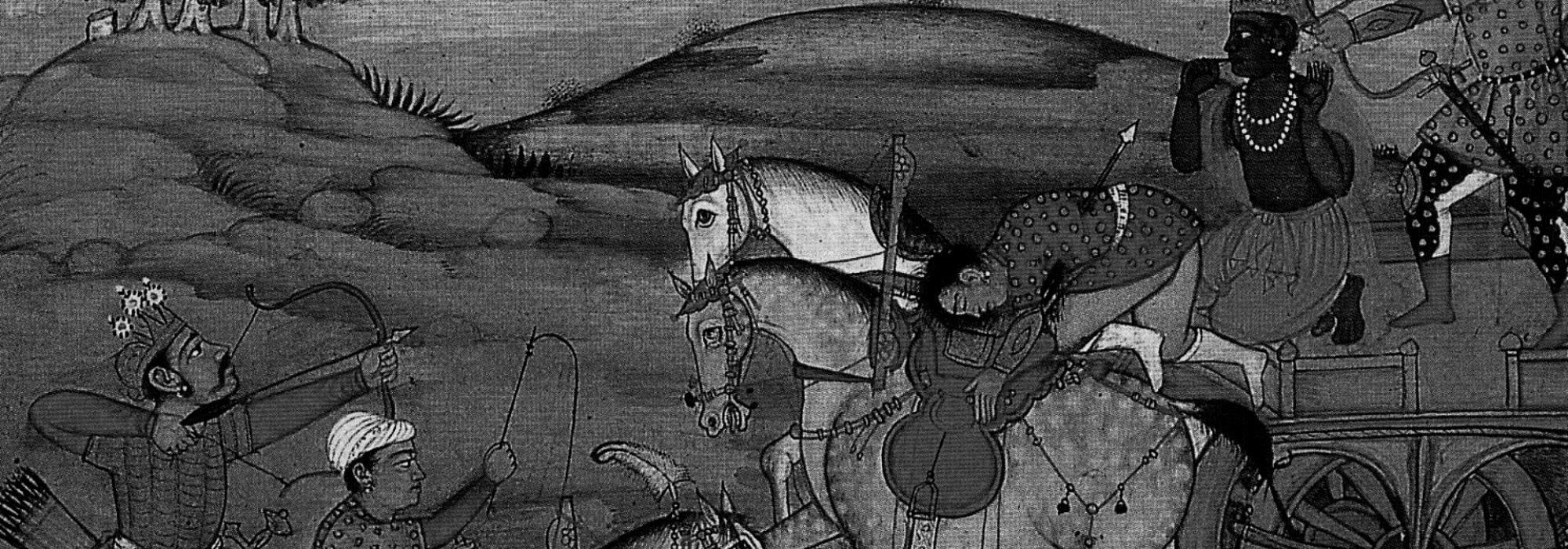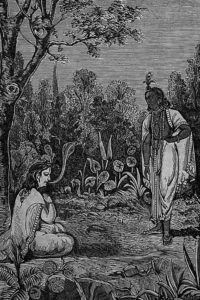In chapter 13 of the Gita (verses 7 to 11) Krishna gives the various parameters that constitute true knowledge:
अमानित्वमदम्भित्वं अहिंसा क्षान्तिरार्जवम् |
आचार्योपासनं शौचं स्थैर्यमात्मविनिग्रहः |७|
इन्द्रियार्थेषु वैराग्यं अनहङ्कार एव च |
जन्ममृत्युजराव्याधि दुःखदोषानुदर्शनम् |८|
असक्तिरनभिष्वङ्गः पुत्रदारगृहादिषु |
नित्यं च समचित्तत्वं इष्टानिष्टोपपत्तिषु |९|
मयि चानन्ययोगेन भक्तिरव्यभिचारिणी |
विविक्तदेशसेवित्वं अरतिर्जनसंसदि |१०|
अध्यात्मज्ञाननित्यत्वं तत्त्वज्ञानार्थदर्शनम् |
एतज्ज्ञानम् इति प्रोक्तं अज्ञानं यदतोऽन्यथा |११|
He stands testimony to each and every one of those qualities:
amanitvam – absence of pride, humility – After defeating the mighty Jarasandha several times, Krishna got tired of war. He thought about his people. If they were constantly attacked, where was the chance to develop as a people? So he decided to go away. He didn’t mind being called a coward if his people would be spared. Without the slightest trace of ego or arrogance, he just went away. Similarly, at the cost of his own reputation, he gave a new life to Narakasura’s wives (BP 10.59).
adambhitvam – absence of hypocrisy, freedom from pretentiousness – Krishna was never ashamed about his past nor did he complain about it. He never tried to cover up his past and lived without pretensions. He was called Govinda, owning to his growing up in Gokula with a cowherd family. He never took that as an offence. He lived his life authentically. Neither did he show off nor did he belittle himself.
ahimsa – freedom from injury or violence – In his life, Krishna never harmed anyone on whim, which is possibly why he says so confidently to Arjuna, “One who strives to do good never ends up in misery” (BG 6.40). Krishna never wishes ill for anyone. Only when people went against dharma, he punished them accordingly. A famous dictum of the Mahabharata is (This verse is not in the critical text but is referred to in the critical edition while quoting from other manuscripts) – अहिंसा परमो धर्मः धर्महिंसा तथैव च – Non-violence is the greatest dharma; no less is violence for the sake of protecting dharma. This is also what he tells Arjuna (BG 2.33). When Krishna killed Kamsa (BP 10.44), he sent all of Kamsa’s wives back to their father’s place, i.e. Jarasandha’s place. When Bhima killed Jarasandha, Krishna assured Jarasandha’s family and the people in his kingdom that they will be fine. Krishna then installed Jarasandha’s son Sahadeva as the king. Jarasandha had captured a thousand kings and put them in prison with a view to eventually kill them. Krishna released them all. When they ask him, “What can we do in return?” Krishna says, “I don’t need anything but it will be good if you can help Yudhisthira with his yajna” (MB 2.18-22; also see BP 10.73). He also genuinely tried to broker peace between the Pandavas and the Kauravas, for he is truly against violence.
kshaanti – forgiveness – Whether it was Kaliya or Shishupala or Gandhari or the hunter who finally killed him, Krishna forgave them all.
arjavam – uprightness, straightforwardness, simplicity – He always called a spade a spade. He never minced his words when point out the mistakes of anyone, even if that was someone who was more powerful or who was a friend. For example, in the Shalya Parva when Duryodhana hides in the lake, Yudhisthira makes a foolish proposition to Duryodhana that if he could defeat any one of the Pandavas in a single combat, he would return the kingdom to him. Krishna rebukes Yudhiṣṭhira, “You have spoken such stupid words. Only Bhima can face Duryodhana in a single combat. You seem to be playing a game of dice all over again!” (MB 9.32).
acharyopasanam – serving the teacher – While the Pandavas and Kauravas had the benefit of private tuition from Drona, Krishna traveled all the way from Mathura to Ujjain to learn from Sandipani. He would go to the forest and get firewood for his teacher. Pandavas and Kauravas never had to do any of that.
shaucham – cleanliness, not just of body but also of speech and mind – Krishna was pure in all three aspects. He epitomizes purity of मनसा वाचा कर्मणा (thought, word, deed).
sthairyam – steadiness, firmness – While Krishna coaxed Arjuna to fight, he himself had fought bigger battles. He showed steadiness and courage when he faced the 28 akshauhini army of Jarasandha (which was bigger than the combined forces of the Pandavas and Kauravas in the Mahabharata). Then he walks into the lion’s den at Girivraja (Jarasandha’s capital) with just Bhima and Arjuna with him. He faced his enemy head on.
atmavinigrahah – self-control – In Krishna’s life, we rarely see any action of rashness. He might have acted with immediacy but that cannot be mistaken for haste or impulsiveness. He was a master of his senses and his self. When Krishna goes for peace talks, Duryodhana tries to capture Krishna. Easily escaping from the clutches of the Kauravas, Krishna says, “I know how to protect myself. O king, if they wish to use violence, let them! On my part, I will not do anything that brings disgrace.”
indriyartheshu vairaagyam – reasoned disregard towards the senses – Krishna never accumulated anything for himself. He wore simple clothes and lived a simple life, never feeding his senses. Krishna never associated himself with people who came to power by wrong means – Kamsa, Jarasandha, Shishupala, or the Kauravas while he was a willing friend of the poverty-stricken Pandavas. He cared for people of genuine virtue and never tried to move closer to the centers of power.
anahankara – freedom from arrogance – Krishna’s elder brother Balarama was a dull fellow. He was an alcoholic, a gambler, and a friend (and teacher) of Duryodhana. During the wedding of Aniruddha (Krishna’s grandson) and the granddaughter of Rukmi, Balarama played dice with Rukmi. Rukmi won by unfair means and yet he teased Balarama for having lost. Balarama lost his cool and killed Rukmi on the spot. The wedding hall turned into a cemetery. Rukmini complained to Krishna that his brother had killed her brother (although she and her brother were not on talking terms for years). Balarama complained to Krishna that his brother-in-law cheated and therefore deserved the punishment. Krishna remained still. He didn’t react (BP 10.61).
janmamrtyujaraavyaadhiduhkhadoshaanudarshanam – insight into the tribulations and miseries of life, death, old age, sickness and pain – Krishna never worried about life or death, old age or disease or pain. He just did his work.
asaktiranabhishvangah putradaaragrhaadishu – dispassionate; unattached to wife, son, home, etc. – Krishna was completely detached from his family and friends. When his wives almost went to auction him off, he sat in the tulabhara and gave away everything to Narada. (This episode is not found in the Critical edition of the Harivamsha; however, the Gorakhpur edition has it). Krishna never spoke a word about it. When his children fought against each other he was not at all bothered by the mayhem; in fact, one might call him an irresponsible father! His son Samba went to the svayamvara of Duryodhana’s daughter Lakshana. When the girl did not choose him, Samba created a ruckus and Duryodhana had him arrested. When Krishna came to know about this, he wasn’t hassled. He merely said, “Let the boy be in jail for some time, then he will learn.” It was Balarama who later went to get him released (BP 10.68). Similarly, he didn’t care about his family prestige when he asked Arjuna to kidnap his sister Subhadra and marry her. He merely did what was right for Subhadra (after all, her parents were not able to find a right suitor for her).
nityam ca samachittatvam ishtaanishtopapattishu – constant equanimity towards desirable and undesirable events – This is a theme that runs through Krishna’s entire life. Neither was he shaken by the unpleasant nor was he taken away by the pleasant. His every step was steady and without hesitation. Several times, accusations were hurled at him but took them all with calmness. Even when Gandhari cursed Krishna telling him that all the members of his clan would kill each other in a fratricidal war, he smiled at her and said, “That happens to be one of the points on my to-do list” (MB 11.25-26).
mayi chananyayogena bhaktiravyabhicharini – unwavering and single-minded devotion to me (i.e. the Supreme) – Krishna knew that he was an avatara and respected the divine within himself but at the same time, he never shirked away from offering prayers to the Supreme being.
viviktadeshasevitvam aratirjanasamsadi – seeking solitude and avoiding sordid crowds – In spite of all his seeming connections with the world, Krishna preferred solitude. He stayed away from the crowd. Even though he was with others, mentally he was detached.
adhyatmajnananityatvam – sincere persistence in knowing the true Self – Krishna always sought to know his true Self and was always directed by his inner voice.
tattvajnanarthadarshanam – constant quest for the truth – Krishna always went behind the truth. He was a true yogi, a true jnani, a true bhakta. In the Ashvamedha parva, Arjuna tells Krishna, “I’ve forgotten your message on the battlefield. It’s been a long time, so please tell me again. I am curious.” Krishna replies, “O fool! Didn’t you get it the first time? Golden words are not repeated. It was a great, eternal secret. I had said that don’t share this message with one who isn’t interested; don’t share it with one who lacks shraddha or tapas. That’s what I said. Now, you have proven to be one without shraddha or tapas! You have become an idiot! I spoke those words to you in a state of deep yoga. Now, even I cannot speak the same words again” (MB 14.16-50). Possibly, this is why Sanjaya calls Krishna yogeshvara, a master of yoga (BG 18.75).
To be concluded.















































